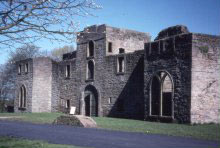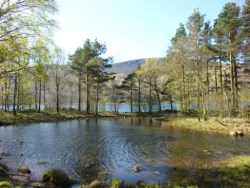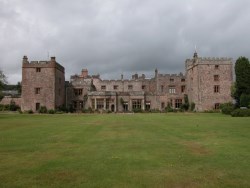Wasdale Head
Wasdale Head is a small hamlet well known to walkers and hikers as the starting point for the most popular route up to the summit of Scafell Pike. For many this is the second stage of the Three Peaks Challenge. The Wasdale Head Inn is known as the birthplace of British climbing and it is surrounded by the highest mountains in England. Apart from Scafell Pike other great climbs nearby include Sca Fell, Great Gable, Kirk Fell and Pillar. The inn's history of housing overnight guests goes back to 1856 when it was first extended for this purpose. In the bar there is a collection of climbing memorabilia.
Wastwater
Wastwater is the deepest lake in England having a depth of 79 metres (258 feet) and is a particularly cold, clear lake. A strange underwater attraction appeared at a depth of 48 metres - a gnome garden, complete with picket fences. In 2005 it was removed by police divers due to a number of deaths which had been put down to divers spending too long underwater trying to find it. However, it appears that the gnomes may simply have relocated to a depth just below 50 metres - for health and safety reasons police divers are not pemitted to dive below 50 metres and therefore cannot go down to remove it again.

Join us on
Please visit the Sitemap to see the full range of information on this site
MountainWalk.co.uk is produced by Trish Haill Associates Copyright
Have you climbed Ben Nevis, Snowdon or Scafell Pike? Or taken part in the Three Peaks Challenge? Or have a special walk you'd like to share? We'd love to here from you! Join us on
or Send us an email.
or Send us an email.
Lake District Coast and Western Lakes
Mountains and the Seaside, Ancient and Modern History
Although people might think of the Lake District as being a land locked area with majestic mountain scenery, the National Park does, in face, extend to the coast. Holidays in this area can have the best of both worlds with the attractive expanse of sandy beaches together with the backdrop of the fells and valleys.
The area is teeming in history with Roman ruins, castles, old towns and a maritime past evident in the ports where you can discover the traditions of the shipbuilding industry and the infamous smuggling trade.
Inland you will find evidence of the mining industry and the maze of railway lines that used to cross the area as well as beautiful peaceful lakes, stately homes and, of course, always against a back drop of some of the most stunning scenery in England.
The area is teeming in history with Roman ruins, castles, old towns and a maritime past evident in the ports where you can discover the traditions of the shipbuilding industry and the infamous smuggling trade.
Inland you will find evidence of the mining industry and the maze of railway lines that used to cross the area as well as beautiful peaceful lakes, stately homes and, of course, always against a back drop of some of the most stunning scenery in England.
Coastal Area
Although the Lake District National Park does not cover the whole of the coastal region of the county of Cumbria, many places just outside of the park are well worth a visit, and so are included in this guide.
View West Coast Area in a larger map
Millom
Starting at the southernmost part of this area is Millom which is surrounded by salt marshes and miles of golden sandy beaches. The Millom Discovery Centre has a reconstruction of a drift mine and a miner's cottage, railway memorabilia and an interesting insight into the first Edwardian tourists to come to the area. The small fishing village of Haverigg is nearby which has safe beaches and adventure play areas for children.
Starting at the southernmost part of this area is Millom which is surrounded by salt marshes and miles of golden sandy beaches. The Millom Discovery Centre has a reconstruction of a drift mine and a miner's cottage, railway memorabilia and an interesting insight into the first Edwardian tourists to come to the area. The small fishing village of Haverigg is nearby which has safe beaches and adventure play areas for children.
Ravenglass
The hamlet of Ravenglass is the only coastal village truely within the Lake District National Park.
Iron and copper ore and granite used to be brought down to the estuary by narrow gauge railway from the mines near Boot. The 7 mile long railway, which first opened in 1875, has been preserved as a tourist attraction.
A journey on the Ravenglass and Eskdale railway travels through beautiful countryside from Dalegarth Station near Boot to the coast at Ravenglass. The train stops at a number of stations along the way, most of which afford photographic, walking or refreshment opportunities. At the end of the line at Eskdale there are a number of sights including Eskdale Mill, Stanley Ghyll Force and Muncaster Castle.
Workington is one of the bigger towns in Cumbria and has its origins as an ancient market town.. It lies at the mouth of the River Derwent and, similar to other ports on this coast expanded rapidly in the Industrial Revolution. Its iron and steel industry continued right up to 2006. Workington port is one of the largest in Cumbria but suffered significant damage where the River Derwent flooded in the devastating floods of November 2009. Following repairs to the harbour to protect it from the risk of future flooding the port has recently secured nearly £6m of investment to transform it into a major container port.
Workington
Workington is one of the bigger towns in Cumbria and has its origins as an ancient market town.. It lies at the mouth of the River Derwent and, similar to other ports on this coast expanded rapidly in the Industrial Revolution. Its iron and steel industry continued right up to 2006. Workington port is one of the largest in Cumbria but suffered significant damage where the River Derwent flooded in the devastating floods of November 2009. Following repairs to the harbour to protect it from the risk of future flooding the port has recently secured nearly £6m of investment to transform it into a major container port.
In 1568 Mary Queen of Scots is said to have spent her last night of freedom at Workington Hall - now a magnificent ruin. Mary was arrested after her stay in the hall and after 18 years of imprisonment she was eventually executed. The hall itself has been closed to the public for some years due to health and safety fears, but an action group is hoping for it to reopen. The grounds and park are open however. Adjacent to the hall is an elegant Georgian House which is home to the Helena Thompson museum. The museum holds children's activity days and its displays reflect the history, industry and social life of the area.

Workington Hall - plans are in place to reopen this historic hall to the public
Seascale
Just outside the national park is the small town of Seascale - probably known best for having the Sellafield Nuclear power plant about a mile away from the town centre. In its own right Seascale is a small but attractive seaside resort. It has been a popular holiday destination since the 1850s with the arrival of the Furness Railway. It has miles of clean sandy beaches with safe bathing. If you are interested in pre-historic remains, Greycroft is a stone circle standing in the shadow of Sellafield. Evidence of our past was not always respected as in 1820 a local farmer buried the stones as they got in the way of his plough. Luckily they were unearthed and restored in 1949. There are ten stones remaining out of an original 12. The stones can be seen from a nearby footpath, but its not easy to park nearby as the roads have parking prohibited due to the proximity of the power station.
Whitehaven
Further up the coast is another Georgian town which is origins set firmly in shipping and mining, Whitehaven. England's first undersea mine was constructed here in 1729. The Haig Pit Mining and Colliery Museum has mine machinery displays, and has exhibitions showing the disasters in the Whitehaven mines which claimed over 1799 lives in total over the years. Other exhibitions show children down the mines, and the social history of the area. As the coal was brought to the port its importance grew and continued to be commercially active until 1992. The town itself is based on planned Georgian architecture so the streets are laid out in a right angled grid. The castle (now private dwellings) was built in 1769. With significant investment in the harbour Whitehaven is now concentrating on the tourist trade.
Maryport
Maryport, home to the Lake District Coast Aquarium which has displays of the creatures of different habitats around our waters, for example, harbour wall, estuary, crashing waves etc. There's other entertainment for the children with an adventure playground, crazy golf and an aquablasta game. Also in Maryport is the Senhouse Roman Museum and a Maritime Museum.
The small village of Allonby just north of Maryport has a long sandy beach which is a designated area of outstanding beauty.
Moving Inland
Cleator Moor
In the 19th century the factories of the Industrial Revolution demanded ever more coal, high grade iron ore and limestone so a maze of railways servicing the many mines grow up to provide the materials for the iron works at Workington and Cleater Moor. There was so much mining activity in Cleator Moor that subsidence meant part of the town needed to be demolished. As the demand for ore and coal grew less, most of the railway lines closed and the old railway line from Ennerdale to Whitehaven, which runs through the Cleator Moor, is now a tarmacced footpath and cycleway. Cleator Moor is not tourist destination as such, but you can join part of the West Cumbria Cycle Network here as there is a convenient car park next to the old railway line.
Egremont
Egremont, a small attractive market town is home to Egremont Castle which was built in the first half of the 12th century. The ruins of the castle are open to visitors. Florence mine was the last working iron ore mine in Europe. Unfortunately the Mine Heritage Centre has recently had to close due to the economics of pumping water from the mine. Insufficient ore is able to be extracted to offset the expensive costs of draining the shafts, and hence the mine has had to be left to flood. The above ground buildings at the mine are being transformed into an arts centre with studio theatre, community cinema and exhibition spaces.
Calder Bridge
Calder Bridge itself is not a tourist centre, but is a dormitory town for the workers at Sellafield. The oldest bridge in the lake district crosses the River Calder in this village and is worth a visit. It was built for the Calder Abbey monks, and the footpath across it leads from the village to the abbey. Although there is no public access to the impressive ruins they can be viewed from the footpath which is suitable for wheelchairs and pushchairs. The round trip is about 2 1/2 miles.

Ennerdale Water
The most westerly of the lakes, and the most remote is Ennerdale Water. There is not a public road up the valley so it is not so popular with tourists. The valley does provide opportunities for biking, riding, climbing and canoeing and historic sites to explore. A partnership, WildEnnerdale, has been formed to manage the area with views to sustainability and keeping Ennerdale Water and valley somewhere where people can excape the hustle and bustle of modern life.
There are over 20 miles of forest paths to explore, however there is an open access policy across the valley so no need to keep to well trodden tracks.
Ennerdale Water - Photo Courtesy Ady Gray
Eskdale
Tourists and walkers going to Scafell Pike or the other nearby mountains find Eskdale a popular destination. It has a full range of accommodation and is in a beautiful walking area. Sights to see in this area include Muncaster Castle, Stanley Ghyll Force and Eskdale Mill.
Muncaster Castle is a historic haunted castle set in 70 acres of gardens. It houses over 200 birds in the World Owl Centre. An audio tour of the elegant castle rooms is narrated by the Pennington family whose ancestors have lived at the castle for over 800 years. Young children will enjoy the Meadowvole Maze where they will feel 5 cm tall in a giant landscape.
Eskdale Mill is located at Boot and hosts historic working machinery. Still in use today, it is one of the oldest water powered corn mills in the Lake District. The Miller takes you on the mill tour and tells tales of the history of the mill and the folk who worked there. There is also a demonstration of the milling process.


Top: Muncaster Castle
Bottom: Bird of Prey Display at Muncaster Castle
Bottom: Bird of Prey Display at Muncaster Castle
Stanley Ghyll Force is one of the most photographed waterfalls in the Lake District. It falls 60 foot through a dramatic steep and narrow gorge. This waterfall became a popular attraction in Victorian times, and was named after the Stanley family who lived at Dalegarth Hall. In summer the vegetation round the waterfall makes it feel almost tropical.
The Hard Knott and Wrynose Passes link Eskdale with the southern lakes.
See the other Lake District Guides
The Wainwrights
Outdoor Activities in the Lake District
Windermere and the Southern Lakes
Kendal and District
Keswick and the North Lakes
Penrith and the Eastern Lakes
Ulverston and South West Cumbria
The Wainwrights
Outdoor Activities in the Lake District
Windermere and the Southern Lakes
Kendal and District
Keswick and the North Lakes
Penrith and the Eastern Lakes
Ulverston and South West Cumbria
Coastal Walks in Cumbria
The Cumbria Coastal Way traverses 182 miles on the Cumbria coast from Silverdale on Morecambe Bay, through the Lake District National Park and on to the border town of Gretna in Scotland. Although a long walk it rarely climbs higher than 100 metres above sea level. It can be walked in 10 to 14 days, or just in sections which are designed to link with public transport.
Wainwright described a west/east coastal walk in the early 1970s which starts at St Bees on the west coast of Cumbria. The walk goes through the Lake District National Park, through the Yorkshire Dales National Park, the North York Moors National Park and ends at Robin Hoods Bay on the east coast of North Yorkshiere. The walk is some 192 miles in total, and Wainwright broke this down into 12 stages, each of which can be accomplished in a day.
The Cumbria Coastal Way traverses 182 miles on the Cumbria coast from Silverdale on Morecambe Bay, through the Lake District National Park and on to the border town of Gretna in Scotland. Although a long walk it rarely climbs higher than 100 metres above sea level. It can be walked in 10 to 14 days, or just in sections which are designed to link with public transport.
Wainwright described a west/east coastal walk in the early 1970s which starts at St Bees on the west coast of Cumbria. The walk goes through the Lake District National Park, through the Yorkshire Dales National Park, the North York Moors National Park and ends at Robin Hoods Bay on the east coast of North Yorkshiere. The walk is some 192 miles in total, and Wainwright broke this down into 12 stages, each of which can be accomplished in a day.
